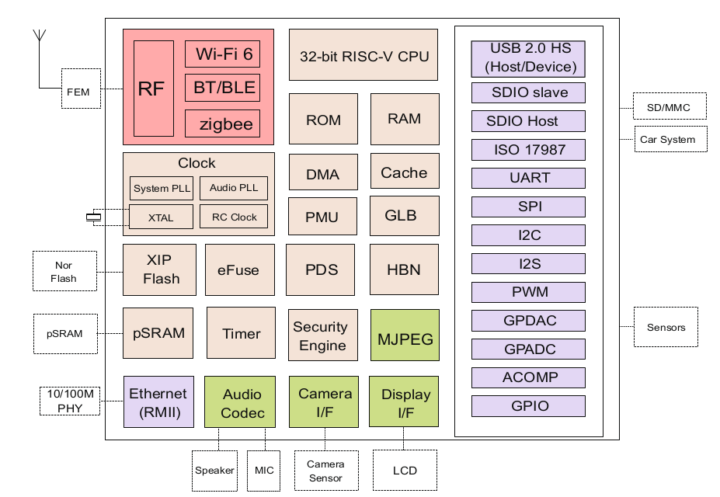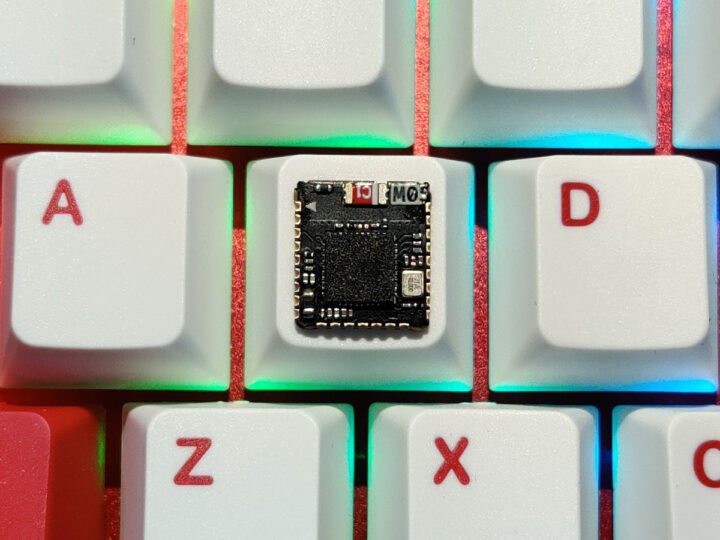Bouffalo Lab BL616/BL618 is a 32-bit RISC-V wireless microcontroller with support for 2.4 GHz WiFi 6, Bluetooth 5.2 dual-mode, and an 802.15.4 radio for Zigbee, Thread, and Matter designed for IoT applications.
We first spotted the BL616 RISC-V IoT MCU during the BL602/BL606 announcement in November 2020, but we had virtually no additional information about it so far. It appears both BL616 and BL618 will be launched next month with the main difference between the two being that BL616 has 19 GPIOs and BL618 comes with 35 GPIOs.

Bouffalo Lab BL616 and BL618 specifications:
- MCU core – 32-bit RISC-V CPU (RV32IMAFCP) @ up to 320 MHz with FPU and DSP, 32KB instruction cache & 16KB data cache
- VPU – MJPEG video encoder
- Memory – 480KB SRAM, 4KB HBN RAM, embedded 4 or 8MB pSRAM (optional)
- Storage – 128KB ROM, 4Kb eFuse, embedded 2, 4, or 8MB flash (optional), XIP QSPI flash support, SD card interface
- Wired networking – 10/100M Ethernet
- Wireless
- 2.4 GHz RF transceiver
- Wi-Fi 6 (IEEE 802.11 b/g/n/ax) 1T1R up to 229.4 Mbps
- Bluetooth 5.x dual-mode (classic + LE)
- Zigbee / IEEE 802.15.4
- WiFi features
- STA, SoftAP, STA+SoftAP, and sniffer modes
- Security – WPS, WEP, WPA, WPA2, WPA3
- LDPC, STBC, Beamforming, DL/UL OFDMA, MU-MIMO, TWT (Target Wake Time), SR(Spatial Reuse), DCM (Dual Carrier Modulation), ER (Extended Range)
- IEEE 802.11e QoS WMM (Wi-Fi MultiMedia), IEEE 802.11w PMF (Protected Management Frames)
- Display I/F – QSPI and DBI interfaces for LCD display
- Camera – DVP interface
- Audio Codec
- 1x ADC (MIC, SNR > 92dB)
- 1x DAC (Speaker, SNR > 95dB)
- Sampling rates – 8, 12, 16, 22.05, 24, 32, 44.1, 48KHz
- Peripherals
- USB – USB 2.0 HS OTG up to 480Mpbs
- SDIO 2.0 slave
- 2x UART (Support 5V IO)
- 2x I2C with host mode support
- SPI master/slave
- I2S master/slave
- 1x PWM (4-channel)
- 12~16-bit general-purpose ADC
- 10-bit general-purpose DAC
- RTC timer
- 2x 32-bit general-purpose timers
- 4x DMA channels
- General analog comparators (ACOMP)
- GPIO – Up to 19x for BL616, up to 35x for BL618
- Security
- Secure boot; Secure debug
- XIP QSPI On-The-Fly AES Decryption (OTFAD)
- Support sensitive SW isolation (TrustZone)
- AES-CBC/CCM/GCM/XTS modes
- MD5, SHA-1/224/256/384/512
- TRNG (True Random Number Generator)
- PKA (Public Key Accelerator) for RSA/ECC
- Clock
- Support XTAL 24/26/32/38.4/40MHz
- Support XTAL 32.768KHz
- Internal RC 32KHz & 32MHz oscillator
- Internal System & Audio PLL
- Debugging – JTAG development support
- Power Modes (Ultra-low Power modes)
- Off ; Hibernate (<1uA)
- Power Down Sleep (flexible)
- Package Type
- 40-pin QFN (BL616)
- 56-pin QFN (BL618)
Bouffalo BL616 and BL818 are supported by the latest version of the open-source bl_mcu_sdk MCU software development kit available on GitHub. You can download the datasheet and reference manual for more details about the microcontrollers. While the new Matter protocol is not mentioned in any of the documents, Bouffalo Lab will be using BL616 for WiFi Matter, BL618 in both Matter border routers and bridges.

The BL616/8 was brought to my attention by Sipeed who is planning to launch the tiny (11x10mm) M0S module by mid-January 2023. The M0S is based on the BL616 RISC-V microcontroller @ up to 384 MHz with WiFi 6, Bluetooth 5.2, and Zigbee, 4MB flash, 512KB SRAM, a ceramic antenna, USB 2.0, and a few other I/Os. Sipeed expects to sell it for less than $2 at launch. You can find more details about the module on Twitter.

Jean-Luc started CNX Software in 2010 as a part-time endeavor, before quitting his job as a software engineering manager, and starting to write daily news, and reviews full time later in 2011.
Support CNX Software! Donate via cryptocurrencies, become a Patron on Patreon, or purchase goods on Amazon or Aliexpress




